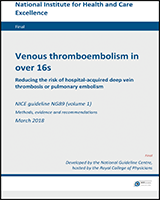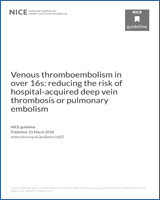NCBI Bookshelf. A service of the National Library of Medicine, National Institutes of Health.
National Guideline Centre (UK). Venous thromboembolism in over 16s: Reducing the risk of hospital-acquired deep vein thrombosis or pulmonary embolism. London: National Institute for Health and Care Excellence (NICE); 2018 Mar. (NICE Guideline, No. 89.)
December 2019: In recommendation 1.3.5 the British Standards for anti-embolism hosiery were updated because BS 6612 and BS 7672 have been withdrawn. August 2019: Recommendation 1.12.11 (1.5.30 in this document) was amended to clarify when anti-embolism stockings can be used for VTE prophylaxis for people with spinal injury.

Venous thromboembolism in over 16s: Reducing the risk of hospital-acquired deep vein thrombosis or pulmonary embolism.
Show details37.1. Introduction
This section covers patients undergoing cardiac surgery.
Factors that may alter the risk of VTE in cardiac surgery:
- Pacing wires and implantable cardioverter-defibrillator devices may lead to an increase in upper limb deep vein thrombosis
Factors that increase the risk of bleeding or hazard associated with it:
- Many patients will be receiving antiplatelet medication, heparin or warfarin and will therefore have an increased risk of bleeding.
Other special factors that would affect the choice of, and use of, specific methods of prophylaxis:
- Several procedures in cardiac surgery involve the use of anticoagulation or antiplatelet therapy:
- Full heparin anticoagulation is used during cardiopulmonary bypass which is typically 1–2 hours of a 2–5 hour surgery.
- Surgeries performed “off pump” (without the use of heart lung machines) are also covered by heparin anticoagulation.
- Most patients with coronary artery disease are given antiplatelet therapy up to shortly prior to surgery and it is recommenced soon after.
- Many patients with valve disease have warfarin anticoagulation.
- Patients in atrial fibrillation will generally have warfarin or other anticoagulants.
- Many cardiac surgery patients have leg veins removed for use as grafts. This would preclude the use of both AES and IPCD during the surgery but they could be used afterwards.
37.2. Review question: What is the effectiveness of different pharmacological and mechanical prophylaxis strategies (alone or in combination) for people undergoing cardiac surgery?
For full details see the review protocol in appendix C.
Table 217
PICO characteristics of review question.
37.3. Clinical evidence
A search was conducted for randomised trials comparing the effectiveness of mechanical and pharmacological prophylaxis strategies (alone or in combination) in people undergoing cardiac surgery. Two new studies were identified (Kolluri 2016171; Myles 2016222). Of the three studies included in the previous guideline (CG92), one study was included116 ,249, and two studies were excluded (Beghi 199318; Ramos 1996249). The included study is summarised in Table 218 below. See also the study selection flow chart in appendix E, forest plots in appendix L, study evidence tables in appendix H, GRADE tables in appendix K and excluded studies list in appendix N.
Summary of included studies
Table 218
Summary of studies included in the review.
Table 219
Clinical evidence summary: IPC + AES + aspirin compared to AES + aspirin.
Table 220
Clinical evidence summary: Aspirin versus no prophylaxis.
Table 221
Clinical evidence summary: Fondaparinux + AES and/or IPCD versus AES and/or IPCD for VTE prophylaxis in people undergoing cardiac surgery.
37.4. Economic evidence
Published literature
No relevant health economic studies were identified.
See also the health economic study selection flow chart in appendix F.
37.5. Evidence statements
Clinical
In one study of very low quality, a possible clinical benefit of IPCD + AES + aspirin was found for the outcome all-cause mortality, however there was very serious imprecision around the estimate, and therefore was also associated with no difference and clinical harm (n=330). For the DVT outcome, evidence from the same study showed a possible clinical harm of IPCD + AES + aspirin, however again there was very serious imprecision around the estimate. There was no clinical difference between the two interventions in terms of PE or fatal PE. The evidence for these outcomes also showed very serious imprecision and was associated with both clinical benefit and clinical harm.
One study compared aspirin to no VTE prophylaxis. There was a possible clinical harm of aspirin compared to no prophylaxis in terms of all-cause mortality, and no clinical difference between the two interventions for the PE and major bleeding outcomes (low quality; n=2100). For all outcomes there was very serious imprecision around the estimate.
One small study of 67 participants compared a combination of fondaparinux and mechanical prophylaxis with mechanical prophylaxis alone. The evidence demonstrated a possible clinical benefit for combined fondaparinux and mechanical prophylaxis in terms of DVT, however there was very serious imprecision around the estimate and therefore was also associated with no difference or clinical harm. No other outcomes were reported.
Economic
- No relevant economic evaluations were identified.
37.6. Recommendations and link to evidence
| Recommendations |
|
| Research recommendation | None |
| Relative values of different outcomes |
The committee considered all-cause mortality (up to 90 days from hospital discharge), deep vein thrombosis (symptomatic and asymptomatic) (up to 90 days from hospital discharge), pulmonary embolism (symptomatic and asymptomatic) (up to 90 days from hospital discharge), fatal PE (up to 90 days from hospital discharge), and major bleeding (up to 45 days from hospital discharge) as critical outcomes. The committee considered clinically relevant non-major bleeding (up to 45 days from hospital discharge), health-related quality of life (up to 90 days from hospital discharge), heparin-induced thrombocytopaenia (duration of study), and technical complications of mechanical interventions (duration of study) as important outcomes. Please see section 4.4.3 in the methods chapter for further detail on prioritisation of the critical outcomes. |
| Quality of the clinical evidence | The committee noted that there was little RCT evidence covering cardiac surgery. The included studies were generally well conducted methodologically with downgrading occurring predominantly due to imprecision. |
| Trade-off between clinical benefits and harms |
The key risks in this patient group are risk of bleeding as they are likely to already be receiving antiplatelet medication. Additionally, this patient group has a high average age, and are likely to have undergone a long operation and a period of immobilisation. Cardiac surgery patients receive a large dose of heparin/anticoagulant during the surgery at the time of clamping, so any pharmacological VTE prophylaxis would not be initiated until after surgery. The committee noted the relatively small amount of evidence in this particular population. The committee pre-specified that if this was the case they would consider the evidence for the abdominal surgery population as indirect evidence. Both cardiac and abdominal surgery involves operations potentially lasting several hours and significant potential for post-operative immobility partly due to the presence of a large incision. The committee discussed the current evidence, considered the previous CG92 recommendations for the cardiac surgery population, as well as the recommendations for the abdominal surgery population. The committee considered that similar pharmacological VTE prophylaxis recommendations could be made for this population as for abdominal surgery patients (LMWH and fondaparinux). The committee considered that the small amount of evidence for fondaparinux identified in the cardiac population suggested a benefit for reducing DVT and that this was a reasonable addition to the recommended options from CG92. However, the use of fondaparinux sodium in the cardiac surgery population is off-label as fondaparinux sodium did not have a UK marketing authorisation for this indication at the time of consultation (October 2017). Therefore the committee recommend LMWH in the first instance and fondaparinux sodium only if LMWH is contraindicated. Mechanical prophylaxis is recommended until the patient is back to normal mobility as the committee believe that mechanical prophylaxis offers little benefit once a patient is mobile. Pharmacological prophylaxis is recommended for a minimum of 7 days because the average duration of trials extrapolated from the abdominal surgery was between 7 and 10 days. |
| Trade-off between net clinical effects and costs |
No economic studies were identified for this review. Unit costs were presented. The committee highlighted that the VTE risk in people undergoing cardiac surgery is high. They discussed that current practice follows the recommendation of CG92, where combined prophylaxis (pharmacological and mechanical) was considered to be cost effective for this population. The clinical evidence presented limited their ability to draw a conclusion specific for this population and that extrapolation from the abdominal surgery population for which combined prophylaxis was recommended would be acceptable. Given the high baseline risk of VTE in this population, it was considered that the additional cost of combined prophylaxis would be off-set by the savings from the averted VTE events. The choice of the mechanical and pharmacological prophylaxis options was considered. It was determined that the options given for the abdominal surgery population should be recommended for the cardiac surgery population to allow for tailored prophylaxis prescribing, accommodating licence restrictions, the presence of contraindications and patient preferences. |
| Other considerations | The committee noted that current practice is to use AES as opposed to graduated compression stockings. In terms of pharmacological prophylaxis, current practice is to give a large dose of heparin pre-operatively which is then reversed post-operatively and a lower dose is then offered. Therefore there is a different risk of VTE in these two distinct stages. |
Footnotes
- ee
At the time of publication (March 2018), LMWH did not have a UK marketing authorisation for use in young people under 18 for this indication. The prescriber should follow relevant professional guidance, taking full responsibility for the decision. Informed consent should be obtained and documented. See the General Medical Council’s Prescribing guidance: prescribing unlicensed medicines for further information.
- ff
At the time of publication (March 2018), LMWH did not have a UK marketing authorisation for use in young people under 18 for this indication. The prescriber should follow relevant professional guidance, taking full responsibility for the decision. Informed consent should be obtained and documented. See the General Medical Council’s Prescribing guidance: prescribing unlicensed medicines for further information.
- gg
At the time of publication (March 2018), fondaparinux sodium did not have a UK marketing authorisation for use in young people under 18 for this indication. The prescriber should follow relevant professional guidance, taking full responsibility for the decision. Informed consent should be obtained and documented. See the General Medical Council’s Prescribing guidance: prescribing unlicensed medicines for further information.
- Cardiac surgery - Venous thromboembolism in over 16sCardiac surgery - Venous thromboembolism in over 16s
Your browsing activity is empty.
Activity recording is turned off.
See more...
